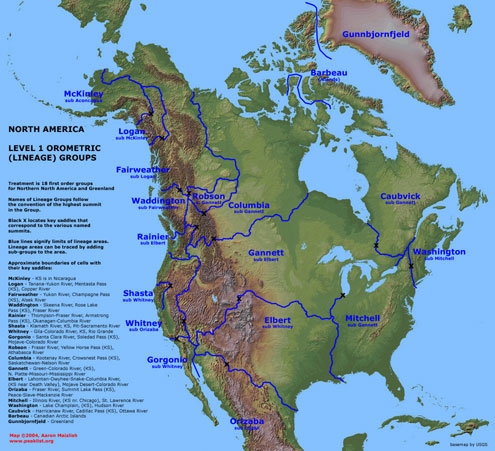| Back to Table of Contents | Back to Theory Page | Forward
to Page 8 |
| PARENT
RELATIONSHIPS AND GROUPS |
Height-Derived |
Height-Derived
plus Prominence |
Height-Derived plus Prominence plus Proportionality |
| Point (Parent) |
Line Parent (NHN): Entirely scale dependent definition of parent but works well for two reasons: Allows us to build a lineage key with a given dataset. Always points us in the right direction across the key saddle. Fewest constraints. |
Prominence Parent (PP): Non-scale dependent definition of parent, but has some limitation. Requires calculation of the parent prominence, which is somewhat unrelated to the mountain in question. IE, the Parent of Whitney requires measurement of Orizaba, not of Whitney itself. Additional constraints. |
Island Parent (IP): Non-scale dependent system works well in some cases (measuring sub-peaks on a major mountain) but is irrelevant in other cases (continental systems.) |
| Line (Lineage) |
Lineage is based on NHN rule: A line of successively higher summits all the way to the island or continental high point. Only constraint is the scale at which low-prominence peaks are included. |
Lineage based on PP rule only: A line of successively more prominent summits. Interesting if the notion is to identify successively greater and greater peaks. Robin Tivy named this the PromLine. |
Lineage based on IP rule only: A matrushka doll nesting philosophy of mountains. Gets to the continental high point pretty quickly. Limited usefulness. |
| Area (Orometric Group) |
Lineage Area: The region of land that counts the summit in the lineage. Size of area unfortunately poorly correlated to importance of the mountain. Fewest constraints system for building cells. |
PALA or Domain: Lineage Area adjusted for Prominence. By addition of one additional constraint, size of domain is now well-correlated with the importance of a mountain. Some peaks can still have huge domains depending on terrain, e.g. Pikes Peak extending to Mississippi River. |
"Prominence Island" Groupings: Not directly analogous. It is possible to draw nested domains based on island parents. Works OK at large scales, but becomes fairly irrelevant at the continental scale. |
 I divided North America into 17 continental regions, as
demonstrated in the map :
I divided North America into 17 continental regions, as
demonstrated in the map :| Forward
to Page 9 |